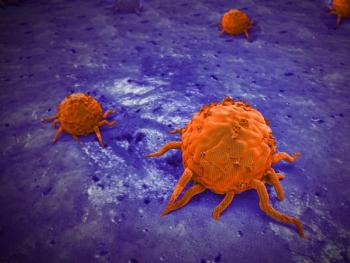
Fixed Duration Venetoclax/Rituximab Combo May Prolong Disease Control in Chronic Lymphocytic Leukemia
Patients with chronic lymphocytic leukemia treated with fixed duration venetoclax/rituximab may experience prolonged disease control vs bendamustine/rituximab.
Fixed duration treatment with venetoclax/rituximab (VenR) for chronic lymphocytic leukemia resulted in significantly lower median minimal residual disease (MRD) levels and prolonged disease control compared with those treated with bendamustine/rituximab, according to results from an MRD model from the phase 3 MURANO trial (NCT02005471).
These results come from the
In the previously reported 5-year update of the trial, investigators found that survival benefit associated with VenR treatment was sustained 3 years following the end of treatment. The median progression-free survival (PFS) was 53.6 months in the VenR arm and 17.0 months in the bendamustine/rituximab arm (P <.0001). Additionally, the 5-year PFS rate was 37.8% in the VenR arm and not estimable in the bendamustine/rituximab arm. Moreover, the 5-year overall survival (OS) rates were 82.1% vs 62.2% in both arms, respectively (P <.0001). Investigators reported that 38.6% of patients in the VenR arm had undetectable MRD without progressive disease at 3-years; the 3-year OS rate was 95.3%.
A total of 389 patients were randomized 1:1 in this trial. Patients were given a 5-week ramp-up dose of venetoclax ranging from 20 mg to 400 mg. Patients were then randomized to either the VenR group (n = 194) and given venetoclax at 400 mg daily or rituximab at either 375 mg/m2 or 500 mg/m2. Alternatively, patients were randomized to the bendamustine/rituximab group (n = 195) and received either 70 mg/m2 of bendamustine or 375 mg/m2 or 500 mg/m2 of rituximab.
The full analysis included 91 patients in the VenR arm and 120 patients in the bendamustine/rituximab arm.
In the VenR arm, 47 patients were younger than 65 years, 18 had a TP53 mutation, 16 had del(17p) and 35 patients had received 2 or more lines of therapy. In the bendamustine/rituximab group, 45 patients were younger than 65, 22 had a TP53 mutation, 18 had del(17p), and 40 had 2 or more lines of prior therapy.
Investigators reported that patients in the VenR group had a significantly longer median MRD doubling time of 93 days compared with 53 days in the bendamustine/rituximab group. The longer doubling time may notably be predictive of a longer PFS and was seen in both VenR (P = 2 x 10-8) and bendamustine/rituximab (P = .001) arms, respectively. Factors that significantly impacted the MRD growth rate included age, VenR treatment, IGHV, TP53 mutation, and tumor lysis syndrome risk at study initiation.
Investigators also observed a numerical shift in time from undetectable to positive MRD conversation that was supported by the MRD growth model. Among those with IGHV mutations (n = 23), 56.5% of patients experienced conversion at a median of 22.6 months (95% CI, 8.1–not evaluable [NE]), and in the IGHV-unmutated (n = 56) subgroup, 64.3% of patients converted at a median of 18.2 months (95% CI, 8.4-28.0). In the subgroup with TP53 wild-type (n = 69) disease, 60.9% of patients experienced conversion at a median of 22.3 months (95% CI, 8.6-28.4); in the TP53-mutated group (n = 13), 69.2% of patients experienced conversion at a median 18.2 months (95% CI, 8.3-NE). Among Forty-five patients who were 65 years or older, 55.6% experienced conversion at a median of 22.6 months (95% CI, 8.7-NE), and 68.4% of 38 patients younger than 65 year experienced conversion at a median of 15.2 months (95% CI, 8.4-28.0).
“These results suggest that, compared with chemoimmunotherapy, fixed-duration venetoclax plus anti-CD20 therapy may contribute to prolonged CLL disease control by slowing the growth of the residual disease clone’s post-treatment cessation,” the investigators concluded.
Reference
Kater A, Lu T, Langeral A, et al. Chronic lymphocytic leukemia (CLL) clonal growth rate is slower following venetoclax-rituximab (VenR): results from a minimal residual disease (MRD) model from the randomized phase 3 MURANO trial. Blood. 2021;138(suppl 1):1551. doi.10.1182/blood-2021-148612
Newsletter
Stay up to date on recent advances in the multidisciplinary approach to cancer.



















































































